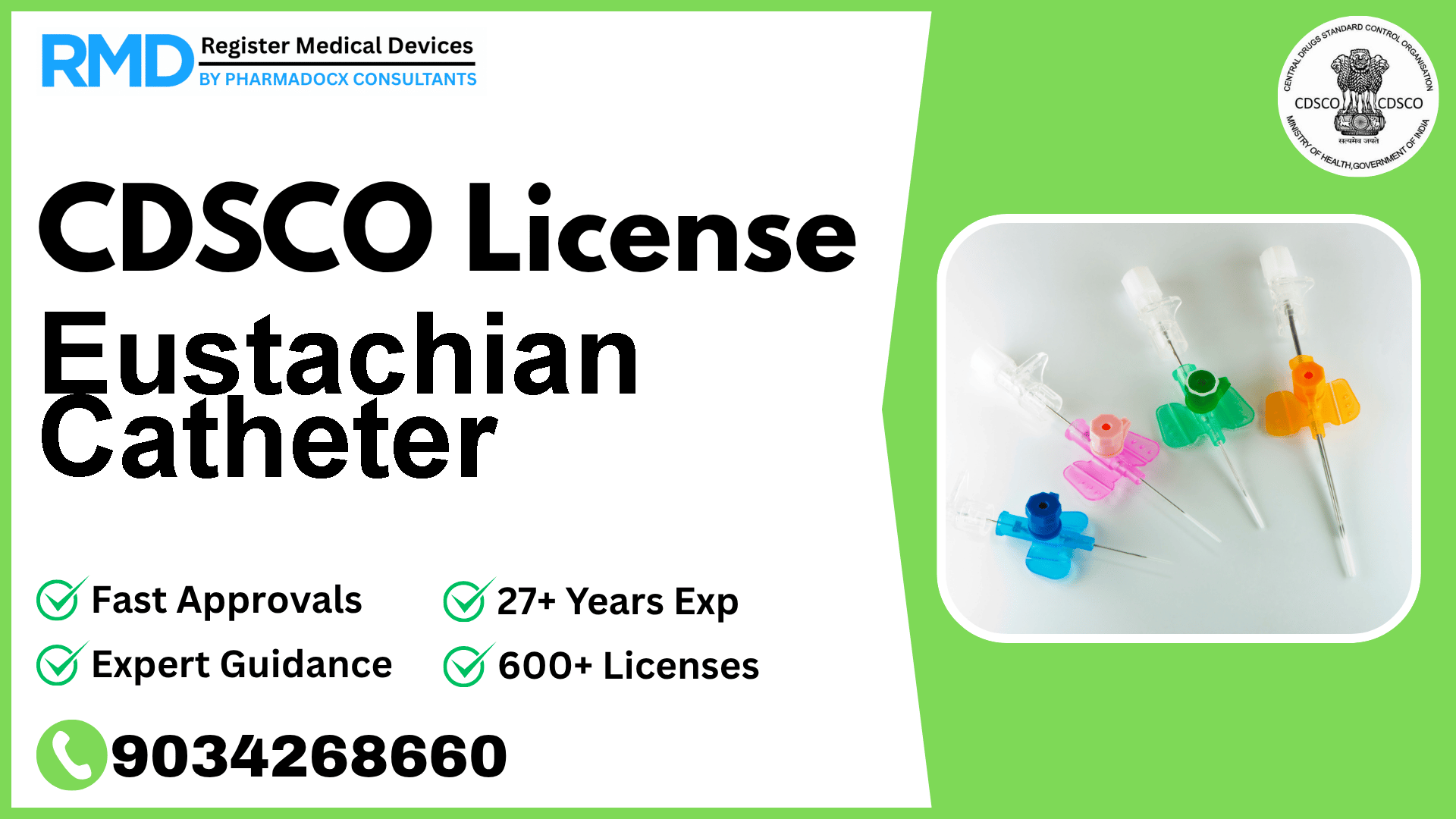CDSCO License for Eustachian Catheter
Medical Device Information
Intended Use
It is used to test Eustachian tube patency

Comprehensive Guide to CDSCO Licensing for Eustachian Catheter (Class B)
As a specialized regulatory consulting firm with over 25 years of experience and 500+ successful CDSCO license approvals, we understand how crucial it is for manufacturers and importers of medical devices like the Eustachian Catheter to navigate regulatory pathways efficiently. This device, classified as Class B under CDSCO regulations, is used specifically to test Eustachian tube patency and falls under the catheter category as per the official notification (29/Misc/3/2017-DC (292), dated 06.06.2018).
Navigating CDSCO’s regulatory framework is essential for legal manufacturing and import of this device in India. Below, we provide a detailed, actionable roadmap tailored for your Eustachian Catheter licensing needs.
CDSCO Regulatory Framework for Eustachian Catheter
The Central Drugs Standard Control Organization (CDSCO) regulates medical devices under the Medical Device Rules, 2017, which classify devices based on risk. Eustachian Catheters, being moderate risk devices, are classified as Class B. This classification determines the licensing authority, application forms, and compliance requirements.
Risk Classification and License Requirements for Class B Devices
Class B devices such as the Eustachian Catheter require an MD5 manufacturing license granted by the State Licensing Authority. The complete process involves obtaining a Test License (Form MD13), product testing in CDSCO-approved labs, technical audits by notified bodies, and final license issuance.
Manufacturing License Process (MD5) for Eustachian Catheter
- Test License Application (Form MD13): Initiate by applying for a Test License to enable product testing. This takes approximately 1.5 to 2 months.
- Product Testing: Samples must be tested at government-approved laboratories. You can find the list of CDSCO-approved testing laboratories.
- Documentation Preparation: Compile required technical and quality documents.
- Submit Manufacturing License Application (Form MD3): Apply for MD5 license through the CDSCO MD Online Portal.
- Audit by Notified Body: A mandatory audit by a CDSCO-recognized notified body ensures compliance. Refer to the notified bodies list.
- Query Resolution: Address any observations or queries raised by the authority or auditor.
- License Grant (Form MD5): Upon satisfactory completion, CDSCO issues the manufacturing license.
Manufacturing License Documents Required for Eustachian Catheter
- Company Constitution Documents (e.g., Incorporation Certificate, Partnership Deed)
- Proof of Ownership or Lease of Manufacturing Premises
- Qualification and Experience Certificates of Technical Staff
- Fire NOC and Pollution Control Board NOC
- Device Master File (DMF), detailing design and manufacturing information (see our detailed Device Master File guide)
- Plant Master File (PMF) describing manufacturing facilities and quality systems (Plant Master File guide)
- Essential Principles Compliance Checklist
- Risk Management File specific to the Eustachian Catheter (Risk Management guidance)
- Test Reports from CDSCO-approved labs
- Labeling and Instructions for Use (IFU)
- Quality Management System Documents (ISO 13485:2016 certification is highly recommended)
Import License Process (MD15) for Eustachian Catheter
If you intend to import Eustachian Catheters, an MD15 license issued by the Central Licensing Authority is mandatory. Unlike manufacturing, no test license is required. The process includes:
- Preparing comprehensive import documentation
- Applying through the CDSCO MD Online Portal
- Resolving any department queries
- Receiving the import license (Form MD15)
Documents required typically include:
- Manufacturing License from the country of origin
- Free Sale Certificate
- ISO 13485:2016 and CE Certificates
- Device and Plant Master Files
- Wholesale License (for domestic distribution)
- Company Constitution
Timeline and Processing Duration
- MD5 Manufacturing License: Approximately 3 to 4 months total. This includes 1.5 to 2 months for the test license phase, product testing, audit scheduling, and final approval.
- MD15 Import License: Typically takes 5 to 6 months due to thorough central evaluation.
Government Fees and Costs
- MD5 License: Rs 5,000 per application + Rs 500 per product (Eustachian Catheter counts as one product).
- MD15 License (Import): For Class B devices, Rs 2,000 per site + Rs 1,000 per product.
Common Challenges and Solutions
- Delays in Testing: Many applicants face delays due to limited slots in CDSCO-approved labs. Proactively book testing early and ensure samples meet lab criteria.
- Incomplete Documentation: Missing or poorly prepared Device Master Files or Risk Management Files cause rejections. Utilize detailed templates and professional support.
- Audit Scheduling Conflicts: Notified body audits must be planned well in advance; coordinate schedules to avoid bottlenecks.
- Regulatory Updates: Stay updated on notifications like 29/Misc/3/2017-DC (292) dated 06.06.2018, as changes can affect classification and compliance.
Expert Consultation and Support
Given the technical and procedural complexity, seeking expert consultation can streamline your application process significantly. Our dedicated team specializes in:
- Preparing compliant Device and Plant Master Files
- Coordinating CDSCO-approved product testing
- Managing audit processes with notified bodies
- Ensuring complete and accurate documentation
We have helped over 500 companies successfully obtain their CDSCO licenses, reducing approval timeframes and minimizing costly rejections.
Getting Started with Your CDSCO License Application for Eustachian Catheter
- Assess Your Device Classification: Confirm your Eustachian Catheter is Class B under current CDSCO rules.
- Register on the CDSCO MD Online Portal: Begin your application process by registering and submitting initial documents.
- Prepare and Submit Test License Application (Form MD13): Start product testing preparations early.
- Organize Required Documentation: Begin compiling your Device Master File, Risk Management File, and other mandates.
- Plan for Audit & Testing: Contact notified bodies and testing labs in advance to schedule audits and sample testing.
- Engage Expert Support: Consider partnering with regulatory consultants to navigate complexities efficiently.
For detailed assistance, visit our comprehensive MD5 License guide or contact us directly to ensure your Eustachian Catheter manufacturing license application is smooth and compliant.
Embarking on your CDSCO licensing journey with expert guidance can save you months of delays and help you launch your Eustachian Catheter successfully in the Indian market.